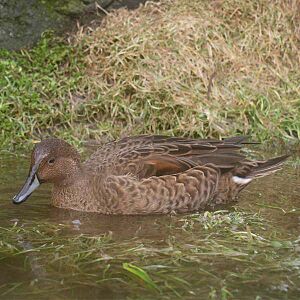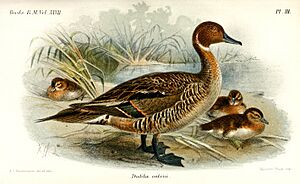Eaton's pintail facts for kids
Quick facts for kids Eaton's pintail |
|
|---|---|
 |
|
| Conservation status | |
| Scientific classification | |
| Genus: |
Anas
|
| Species: |
eatoni
|
| Subspecies | |
|
|
| Synonyms | |
|
Dafila eatoni |
|
The Eaton's pintail (Anas eatoni) is a type of dabbling duck. It is sometimes called the southern pintail. This duck lives only on the Kerguelen and Crozet island groups. These islands are found in the southern Indian Ocean.
This duck looks like a small female northern pintail. It was named after Alfred Edwin Eaton, an English explorer and naturalist. The Eaton's pintail is currently a vulnerable animal. This means it is at risk from introduced species, like feral cats. Cats prey on these ducks, especially when the ducks cannot fly. This happens after they breed, when they are changing their feathers.
Contents
About the Eaton's Pintail
Why It's a Unique Duck
Scientists used to think the Eaton's pintail was just a type of northern pintail. However, they are quite different. The Eaton's pintail is much smaller. For example, a female Eaton's pintail weighs about 450 grams. A female northern pintail, though, weighs around 871 grams.
Also, male Eaton's pintails look similar to the females. Northern pintails, however, have very different looking males and females. These differences helped scientists decide that Eaton's pintail is its own unique species.
How It Was Discovered
Richard Bowdler Sharpe first described this species. He used ducks collected by Alfred Edwin Eaton. Sharpe also noted that other ducks of this kind were collected earlier. These were found during the Ross expedition.
Types of Eaton's Pintail
There are two main types, or subspecies, of Eaton's pintail:
- A. eatoni eatoni: This one is known as the Kerguelen pintail.
- A. eatoni drygalskii: This one is called the Crozet pintail.
What Eaton's Pintails Look Like
The Eaton's pintail is a small duck. It grows to be about 35 to 45 centimeters long. Its wingspan, which is how wide its wings are when spread, is about 65 to 70 centimeters.
Male ducks usually weigh between 430 and 502 grams. Females weigh a bit less, from 400 to 500 grams. Both male and female adults are mostly brownish. Their undersides have a cinnamon color.
You can tell males and females apart by their wing feathers. Males have a green patch on their wings called a speculum. Females have a brown speculum. Males also have longer central tail feathers. Young ducks look similar to adults but have more streaks on their undersides.
Where Eaton's Pintails Live
Their Island Homes
Eaton's pintails live only on the Kerguelen Islands and Crozet Islands. Sometimes, one might fly to the nearby Prince Edward Islands. But this is very rare.
Their Habitat
During the summer, these ducks live near small lakes, ponds, and marshes. They like other freshwater wetlands. In the winter, many freshwater areas freeze over. So, the ducks move to coastal bays.
How Eaton's Pintails Behave
What They Eat
Eaton's pintails mostly eat small crustaceans. They also eat other tiny water creatures called invertebrates. Sometimes, they will eat seeds too. They have even been seen visiting areas where southern elephant seals rest. They go there to find food.
Breeding and Nests
These ducks breed from November to March. They build their nests in thick grass or tussock plants. They line their nests with soft moss and down feathers.
Their Sounds
The sounds of the Eaton's pintail are similar to the northern pintail's. Males make a soft "proop-proop" whistle. Females make a "quack" sound. However, their calls are higher-pitched and quieter.
Staying Safe from Predators
The brown skua is a main predator of the Eaton's pintail. This is especially true when the ducks cannot fly. This happens after they breed, when they lose their old feathers and grow new ones. During this time, Eaton's pintails often hide in thick plants or caves to stay safe.
Status of the Eaton's Pintail
The IUCN lists the Eaton's pintail as a Vulnerable species. This means it faces a high risk of becoming extinct in the wild. The number of these ducks seems to be stable right now. However, they are still threatened by animals brought to the islands. These include cats and rats.
There was an attempt to introduce these ducks to Île Amsterdam. But it was not successful. No Eaton's pintails have been seen there since 1970.



